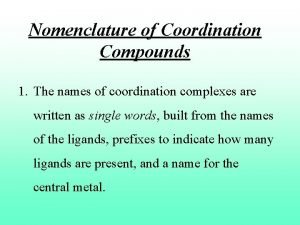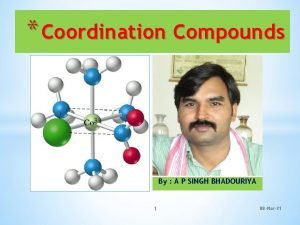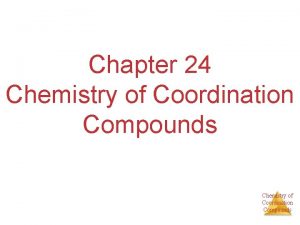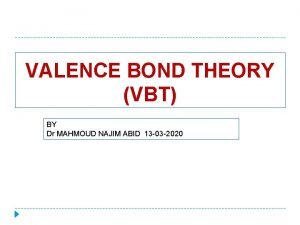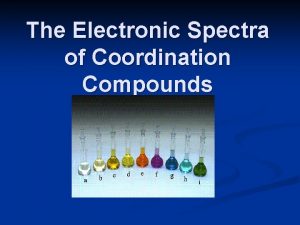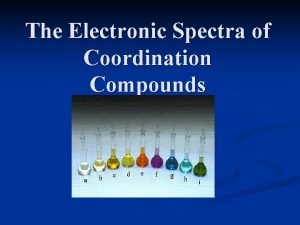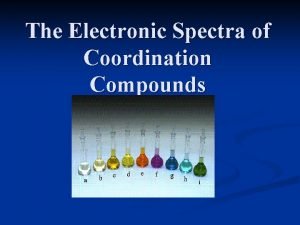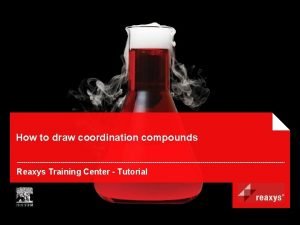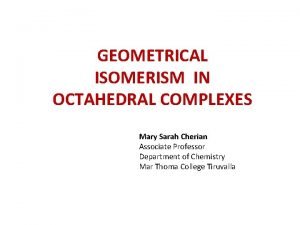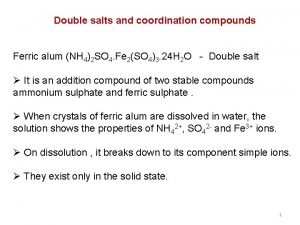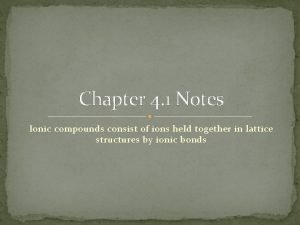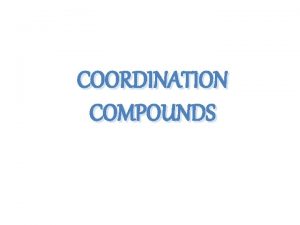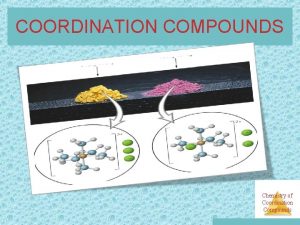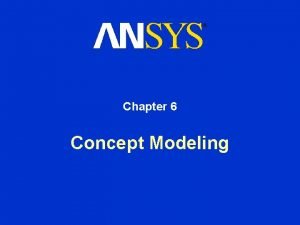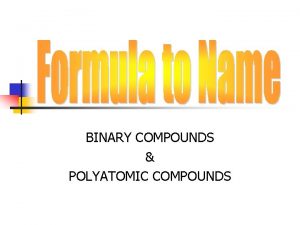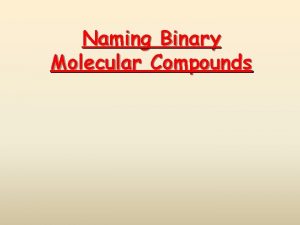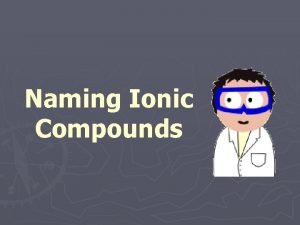COORDINATION COMPOUNDS CONTENTS Introduction Coordination Compounds Concept of















![Example : [Fe. Cl 2(NH 3)4] Example : [Fe(NH 3)3 Cl 3] Example : [Fe. Cl 2(NH 3)4] Example : [Fe(NH 3)3 Cl 3]](https://slidetodoc.com/presentation_image_h2/f1bedb1f9884468b03c759b383c2b90c/image-16.jpg)
- Slides: 16

COORDINATION COMPOUNDS

CONTENTS Ø Ø Ø Introduction Coordination Compounds Concept of Ligands Werner’s Theory Effective Atomic Number Isomerism in Coordination Compounds

INTRODUCTION Coordination compounds are the inorganic salts formed by the combination of two or more simple compounds in stoichiometric ratio. These compounds stable in solid state as well as in liquid state. Example: Chlorophyll, hemoglobin are coordination compounds of magnesium and iron. Variety of metallurgical processes, industrial catalysts and analytical reagents involve the use of coordination compounds. Coordination compounds also find many applications in electroplating, textile dyeing and medicinal chemistry.

DIFFERENCE BETWEEN A DOUBLE SALT AND A COMPLEX SALT Double salts : These are addition compounds in which individual constituents retain there identity. Example : Carnallite ( KCl. Mg. Cl 2· 6 H 2 O) Mohr’s Salt (Fe. SO 4. (NH 4)2 SO 4. 6 H 2 O) Complex salts: These are addition compounds in which individual constituents lose there identity in solid as well as in liquid state. Example: K 4[Fe(CN)6]

DEFINITIONS OF SOME IMPORTANT TERMS PERTAINING TO COORDINATION COMPOUNDS Ø Coordination entity: a coordination constitutes a central metal atom or ion bonded to a fixed number of ions or molecules. For example – [Fe(CN)6]4 -. Ø Central atom/ion: In a coordination entity, the atom/ion to which a fixed number of ions/groups are bound in a definite geometrical arrangement around it, is called the central atom/ ion. ØCoordination numbers : The coordination numbers (CN) of a metal ion in a complex can be defined as number of ligand donor atoms to which the metal is directly bonded. ØCoordination Sphere : The central atom/ ion and the ligands attached to it are enclosed in square brackets and is collectively termed as the coordination sphere. The ionisable groups are written outside the bracket and are called counter ions.

Ligands: Ligands is electron donating species( ions or molecules) bound to the Central atom in the coordination entity. These may be charged or neutral. LIgands are of the following types : Ø Unidentate It is a ligand, which has one donor site, i. e. , the ligand bound to a metal ion through a single donor site. e. g. , H 2 O, NH 3, etc. Ø Didentate It is the ligand. which have two donor sites. Ø Polydentate It is the ligand, which have several donor sites. e. g. , [EDTA]4 - is hexadentate ligand.

Ø Ambidentate ligands These are the monodentate ligands which can ligate through two different sites, e. g. , NO-2 , SCN- , etc. Ø Chelating ligands Di or polydentate ligands cause cyclisation around the metal atom which are known as chelate IS , Such ligands USes two or more donor atoms to bind a single metal ion and are known as chelating ligands.

Examples of ligands

WERNER’S THEORY OF COORDINATION COMPOUNDS Werner in 1898 propounded his theory of coordination compounds. The main postulates are : Ø In coordination compounds metals shows two types of linkages (valences) – primary and secondary. Ø The primary valences are normally ionisable and are satisfied by negative ions. Ø The secondary valences are non – ionisable. These are satisfied by neutral molecules or negative ions. The secondary valence is equal to the coordination number and is fixed for a metal. Ø The ions/groups bound by the secondary linkages to the metal have characteristic spatial arrangements corresponding to different coordination numbers.

In modern formulations, such spatial arrangements are called coordination polyhedral. The species within the square bracket are coordination entities or complexes and the ions outside the square bracket are called counter ions. This approach correctly predicts there would be two forms of Co. Cl 3 4 NH 3. The formula would be written [Co(NH 3)4 Cl 2]Cl. One of the two forms has the two chlorines next to each other. The other has the chlorines opposite each other.

Effective Atomic Number (EAN) This concept was proposed by Sidgwick. In a complex, the EAN of metal atom is equal to the total number of electrons present in it. EAN = Z – X+Y where, Z = atomic number of metal atom X = oxidation number of metal and Y = coordination number of complex An ion with central metal atom having EAN equal to next inert gas will be more stable.

Isomerism in Coordination compounds ( compounds that have the same composition but a different structural arrangement of atoms ) Structural Isomerism Stereoisomerism Geometrical (Same frame work but different spatial arrangement of the ligands) Optical (non-superimposable mirror images) Ionization Hydrate Coordination Linkage Polymerization Ligand isomer

Geometrical isomerism: Isomerism occurs when ligands occupy different types of positions around the central metal ion. Ø If the ligands occupy the positions adjacent to one another, then it is called cis-form ØIf the ligands occupy the positions opposite to one another, then it is called trans-form B A M M B A cis B A A B trans

Geometrical isomerism in complexes with coordination number 4 Ø Tetrahedral complexes do not show geometrical isomerism, Bcoz all the ligands are equidistant from one another. ØSquare planar complexes of formula [MX 2 L 2] (X and L are unidentate) show geometrical isomerism. The two X ligands may be arranged adjacent to each other in a cis isomer, or opposite to each other in a trans isomer, e. , A M B A B

Geometrical isomerism in complexes with coordination number 6: The metal complexes with coordination no. 6 possessed of octahedral geometry and they exhibit both geometrical and optical isomerism. Geometrical isomerism is not observed in 1. complexes of co-ordination number 2 and 3. 2. Complexes of tetrahedral geometry. 3. Complexes Ma 3 b or Mab 3 or Ma 4 of square planar geometry. 4. Complexes Ma 6 and Ma 5 b of octahedral geometry.
![Example Fe Cl 2NH 34 Example FeNH 33 Cl 3 Example : [Fe. Cl 2(NH 3)4] Example : [Fe(NH 3)3 Cl 3]](https://slidetodoc.com/presentation_image_h2/f1bedb1f9884468b03c759b383c2b90c/image-16.jpg)
Example : [Fe. Cl 2(NH 3)4] Example : [Fe(NH 3)3 Cl 3]
 M(ab)3 optical isomers
M(ab)3 optical isomers Coordination compound nomenclature
Coordination compound nomenclature Difference between double salt and complex compound
Difference between double salt and complex compound Werners theory of coordination compounds
Werners theory of coordination compounds Werner's coordination number
Werner's coordination number Postulates of vbt theory
Postulates of vbt theory Electronic spectra of coordination compounds
Electronic spectra of coordination compounds Electronic spectra of coordination compounds
Electronic spectra of coordination compounds Correlation diagram in coordination chemistry
Correlation diagram in coordination chemistry Drawing coordination compounds
Drawing coordination compounds Geometrical isomerism
Geometrical isomerism Hexadentate ligand
Hexadentate ligand Contents introduction
Contents introduction Venn diagram of ionic and covalent bonds
Venn diagram of ionic and covalent bonds Concept de coordination
Concept de coordination Concept 2 notes naming ionic compounds
Concept 2 notes naming ionic compounds Actual self and ideal self are based from
Actual self and ideal self are based from

